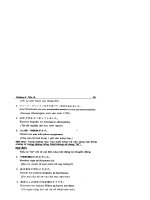4eSample poster 4 evaluation
Bạn đang xem bản rút gọn của tài liệu. Xem và tải ngay bản đầy đủ của tài liệu tại đây (20.52 KB, 2 trang )
The Effects of Different Levels of Fertilization on Brassica rapa Plants
Allderdice, Diehl, Thansum
Presented in an introductory course for non-majors at Bucknell University
Layout and Appearance
Criteria
Positive
Negative
APPEARANCE: Is the poster neatly constructed? Do the text and the figures stand
out against the background? Are colors
and fonts used consistently? Is the text
large and legible from 3–6 feet away?
SECTIONS: Does each section begin with
a descriptive heading? Is there sufficient
space between sections? Do the sections
naturally flow from top left to bottom
right?
BALANCE: Is there a nice balance between text and figures? Is there too much
text?
PROOFREADING: Is the text free of typos and grammatical errors?
Poster is neatly
constructed.
Nice use of colored paper for contrast.
Each section has
a descriptive heading.
Good use of
space.
Layout flows
from top left to bottom right.
Good balance
between text and
figures.
Make font size of body larger.
Reduce amount of text by using
bullets for the main points.
There are a number of grammatical errors and word choice issues
(e.g., “ring” instead of “wring”; “effect” instead of “affect”).
Content
Criteria
Positive
Negative
TITLE: Does the title grab your attention?
AUTHORS: Are the authors’ names, affiliations, and contact information provided?
INTRODUCTION: Were the objectives
clearly stated? Do you understand why
this study was done? Did you get enough
background information to understand the
system? Were any abbreviations defined
for the general visitor? Were the hypotheses rational?
METHODS: Were the methods described
clearly and concisely?
RESULTS: Were the graphs easy to understand? Were any graphics distracting?
CONCLUSIONS: Do the conclusions
match the data? Are reasonable ideas put
forth to explain the observed patterns? Is
there a clear connection between the conclusions and the original objectives?
Hypothesis is
clearly stated in the
introduction.
Methods are
clearly described.
Graphs are easy
to understand.
The conclusions
are supported by
the data.
Potential sources
of error are pointed
out.
Title is descriptive, but does not
hint at the results.
Center authors’ names below the
title.
In the introduction, do not say:
“prove our hypothesis right or
wrong.” Instead, say something like
“to test our hypothesis” or “to see if
our hypothesis is supported or negated.” Use CSE in-text citation
format 1 in the introduction.
Each item in the methods section
could be shortened by eliminating
“we” did this and that.
In the photos, include a ruler as a
size bar. Include a caption that states
the important result.
Graph format: delete gridlines
and gray background; choose dark
colors for lines and symbols (the yellow line on the gray background is
barely visible).
Delete the first paragraph of the
results section. Describe the actual
1
Council of Science Editors, Style Manual Committee. 2006. Scientific style and format: The CSE manual for authors, editors, and publishers. 7th ed. Reston (VA): The Council. 680 pp.
results, not just the variables on the
axes. Where is Figure 3? Do not interpret the results in the results section (e.g. “This data suggests
that…”); save interpretations for the
conclusion.
There is a discrepancy between
the variables you measured (height,
# leaves, # buds) and the variable
mentioned in the hypothesis (chlorophyll). Therefore, there is no clear
connection between the conclusions
and the hypothesis.
The Work cited section is out of
place.









